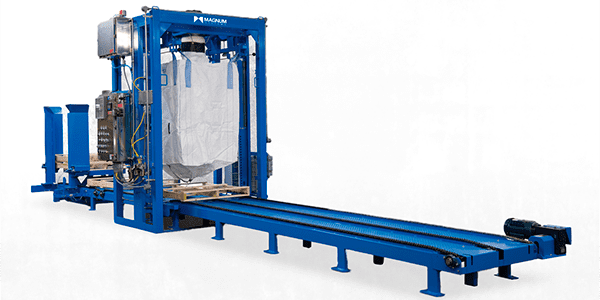

Lithium Carbonate: A Key Ingredient in EV Batteries
As a leader in bulk materials handling and packaging systems, Magnum Systems is well-equipped to serve processors of lithium carbonate.
An Operational Overview
When choosing bulk bag-filling equipment for your plant, it’s a good idea to start with a general overview of how it operates.
Typically, bulk bag fillers consist of a bag frame to hold the bag, a product flow control valve or gate, and a weighing scale system with controls. They range from simple, basic frames to more sophisticated systems, including pallet dispensers and accumulation conveyors for filled bags.
The bulk bag-filling process involves an operator hanging the bag from the filler frame and attaching the fill spout or the bulk bag’s neck to the filler. Once a bag is attached, a neck seal with a dust collection port can be inflated to reduce airborne dust during the fill cycle.
Finally, the flow of product into the bag is shut off, and the filled bag is ready to be removed from the filler as soon as the bag is filled to the required weight.
Considerations When Choosing Bulk Bag-Filling Equipment for Chemical Industry Use
Equipment and Bag Size
Bulk bag-filling equipment must be sized to accommodate the physical dimensions of the bag to be filled as well as the weight of the product.
Taylor’s IBC 3000 bulk bag fillers have a maximum capacity of 3,000 pounds. The IBC's modular design provides ultimate flexibility, from free-standing manual operation to a fully integrated and automated system that handles bags, drums and boxes.
Construction Materials
It is essential that bulk bag-filling equipment be constructed of materials that can withstand a product’s corrosive characteristics if any are present.
Stainless steel product contacts are standard on the IBC, and the equipment can either be painted or all stainless steel.
Experts in Filling Bags with Lithium Carbonate
Understanding each customer’s process prior to bag filling is crucial. Some customers can either start or stop during the filling process, while others need to keep the process continuing nonstop. Different needs require different approaches, and we work with each customer to understand what they need to achieve their goals. Filling bags with a material like lithium carbonate needs to be approached mindfully, including knowing what happens before and after the bag is filled.
A silo or surge bin holds the ready-to-package product. The product then flows through a knife gate (for either a fast or slow flow) into the bulk bag filler, which fits below the surge bin. As the bag fills to weight, the gate closes.
The bulk bag filler’s platform can include a vibration feature if the product requires vibrating to settle for accurate volume and/or weight. Often powders, such as lithium carbonate, greatly benefit from platforms that can vibrate. The preact, or setpoint controls, bulk dribble fill by closing the gate in order to slow the flow rate. A feed screw or conveyor belt are alternative ways to fill bulk bags. The automated controls can slow the speed of the screw or belt as well as stop the flow during the fill cycle. The scale control also automates the exact bag weight.
Some bag fillers fill the bag while it rests on a platform scale. Alternately, there are great benefits to filling a bag while it is suspended by straps. Some benefits of using the automated IBC with the bags hung by straps and filled while suspended are as follows:
Magnetics and Metal Detection
For a consistent product, our customers need the ability to find any unwanted metals, such as metal shavings or an errant bolt. Customers may use a more basic static magnet or a vibrating sifter magnet, the latter of which is specifically designed to handle lithium. While it is a significant investment, the vibrating sifter magnet is a robust piece of equipment that comes with its own cooling system. The magnet sifts while grabbing metals, which ends in a much cleaner and consistent product. We collaborate with each of our customers to determine what type of metal detection will work best for them and their end goals.
Sampling: Auger Versus Cross-Sectional
Understanding the importance of sampling is an integral part of the overall handling process. Depending on the quality requirements of our customers, we help them determine which style of sampling is appropriate. An auger-style sampler is a small sample taken from a specific area where the auger is inserted. It works well for a lot of customers and is fine for a pilot project or a smaller production. On the higher end of sampling, there is cross-sectional sampling, which is done with equipment that can take a sampling from a cross-section of the product, transversing the entire width of the hopper. Again, we work with our customers to come up with the best solution to fit their project.
Class/Division-Rated Areas
If a product generates dust or releases vapors while filling the bag, the area may be rated by electrical class or division ratings like Class I or II, or Division 1 or 2. These require that precautions be built into your bulk bag-filling electrical equipment.
Precautions include:
Operator Convenience
In the late 1970s, Magnum Systems’ Taylor Products became one of the first companies to build bulk bag fillers. Safety is critical in the chemical industry. We stand by the belief that the more convenient equipment is to operate, the safer it is for the operator. The IBC boasts the following:
Magnum Systems Matches Bulk Bag Fillers to Suit Your Needs
Magnum Systems has the right solution to accurately match lithium carbonate characteristics, bag size, environment rating, operators’ needs and more. Please contact our customer support and sales representatives to help answer any of your questions.